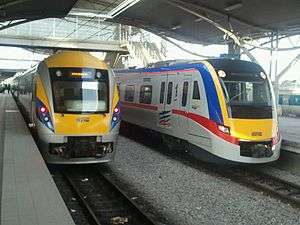Keretapi Tanah Melayu
Keretapi Tanah Melayu (KTM) (Jawi: كريتاڤي تانه ملايو برحد) or Malayan Railways Limited is the main rail operator in Peninsular Malaysia. The railway system dates back to the British colonial era, when it was first built to transport tin. Previously known as the Federated Malay States Railways (FMSR) and the Malayan Railway Administration (MRA), Keretapi Tanah Melayu acquired its current name in 1962.[1] The organisation was corporatised in 1992, but remains wholly owned by the Malaysian government.
 | |
| Overview | |
|---|---|
| Headquarters | Kuala Lumpur |
| Reporting mark | KTM |
| Locale | Peninsular Malaysia |
| Dates of operation | Since 1885 - present– |
| Technical | |
| Track gauge | 1,000 mm (3 ft 3 3⁄8 in) metre gauge |
| Length | 1,700 km (1,100 mi) |
| Government-linked company | |
| Founded | 1992 |
| Headquarters | Jalan Sultan Hishamuddin, 50621 Kuala Lumpur, Malaysia |
Key people | Datuk Dr. Rameli bin Musa, Chairman KTMB Datuk Ir Kamarulzaman Zainal, CEO KTMB |
| Services | KTM INTERCITY
KTM KOMUTER KTM KARGO |
| Website | www |
Railway network
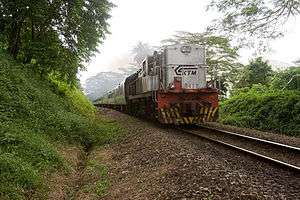
The 1,000 mm (3 ft 3 3⁄8 in) gauge network consists of two main lines and several branch lines.
The West Coast Line runs from the Malaysia-Thailand Border, where it connects with the State Railway of Thailand, to Woodlands Train Checkpoint in Singapore, serving the West Coast states of Peninsular Malaysia. The line runs through most of the major stations in Peninsular Malaysia, such as Gemas, KL Sentral, Ipoh, Butterworth and Padang Besar railway station.
East Coast Line
The East Coast Line branches off from the West Coast line at Gemas, running to Tumpat in Kelantan, serving two of Peninsular Malaysia's East Coast states, namely Pahang and Kelantan. Despite its name, it does not run along the coast at all and only meets the South China Sea when it reach at Tumpat railway station. It runs through the interior, often through deep jungle, thus earning the nickname Jungle Railway.
Branch lines in operation
There are several branch lines running from the two main lines.
KTM Intercity
- Gemas - Johor Bahru Sentral - Gemas
- Johor Bahru Sentral - Tumpat - Johor Bahru Sentral
- Gua Musang - Kuala Lipis - Gua Musang
- Gua Musang - Tumpat - Gua Musang
- Dabong- Tumpat - Dabong
- Johor Bahru Sentral - Woodlands - Johor Bahru Sentral (Shuttle Tebrau)
KTM Komuter
a) Klang Valley Sector
- Pelabuhan KLang - Tanjung Malim - Pelabuhan Klang
- Pulau Sebang - Batu Caves - Pulau Sebang
- KL Sentral - Skypark Link - KL Sentral (Skypark Link)
b) Northern Sector
- Padang Rengas - Butterworth - Padang Rengas
- Butterworth - Padang Besar - Butterworth
KTM KARGO
- Bukit Ketri - Kuang (Cement)
- Padang Rengas - Batu Caves (Cement)
- Padang Rengas - Gelang Patah (Cement)
- Kanthan - Padang Jawa (Cement)
- Tasek - Gelang Patah (Cement)
- Prai - Padang Besar (South Thai Cargo)
- Pelabuhan Klang - Prai (Landfeeder)
- Pelabuhan Klang - Padang Besar (Landfeeder)
- Pelabuhan Klang - Ipoh (Landfeeder)
- Pelabuhan Klang - Pasir Gudang (Landfeeder)
- North Port - West Port (Inter Terminal Transfer)
- West Port - North Port (Inter Terminal Transfer)
- PTP - Pasir Gudang (Inter Terminal Transfer)
- Prai - Thungsong (Landbridge)
- Prai - Surathani (Landbridge)
- Prai - Padang Besa (Thai) - (Landbridge)
- Pelabuhan Klang - Hatyai (Landbridge)
- Sungai Way - Bangkok (Landbridge)
- Prai - Sungai Buloh (Sugar)
- Gurun - Butterworth (Urea)
Infrastructure
The total network spans 1677 km. The total length of the network was 1,700 km, however due to the closure and subsequent removal of the section of tracks between Tanjong Pagar railway station and Woodlands Train Checkpoint, the network is now shorter.
The West Coast line is double tracked and electrified between Padang Besar and Gemas, along with all branch lines used for passenger service along this stretch. As part of the upgrades, all level crossings have been removed and modern signaling installed.
The stations along these line are a combination of heritage stations from the colonial era, such as Ipoh railway station and Kuala Lumpur railway station, and modern stations that were built when the line was double tracked, such as Taiping, Butterworth, Arau station.
The remainder of the West Coast main line from Gemas Station to Johor Bahru Sentral Station is still being in the process of being double tracked and electrified which classified as Gemas - Johor Bahru Electrified Double Track Project.
The East Coast line is single tracked. Having not seen much upgrades over the years, the line is considerably less modern than the upgraded sections of the West Coast line. Level crossings are still prevalent and the traditional token signaling system is still used. The stations along this line are older than smaller. Although the line will remain single tracked, rehabilitation works are underway to replace the worn track and many stations are also being upgraded.
Most of the lines use concrete sleepers, which had replaced wooden sleepers from 1982 for the Kerdau-Jerantut and Sungai Yu-Tumpat lines and became more widespread after upgrading works in recent years.
When the East Coast Line rehabilitation work and West Coast line double tracking is complete, the network will exclusively use concrete sleepers.
Rolling stock
Following the consolidation of all state railway entities in Malaya, Malayan Railway inherited a fleet of mostly British-made steam locomotives, a variation of locomotives introduced to Malaya since its first railway line went into operation.
Dieselisation in Malaya began immediately after MR's formation with the launch of its first diesel engine, a Class 15 shunter, in 1948.
The first mainline diesel went into service in 1957. Since then, a large scale effort to fully convert to diesel power between the 1950s and 1970s effectively drove steam locomotives out of service by 1974.
KTM drew its diesel rolling stock from a multitude of locomotive companies from England, Japan, Canada, and more recently, India, Germany and China.
The company ordered railcars and railbuses for short distance journeys in the 1950s and 1980s respectively, but such services didn’t last. DMUs are being ordered for unelectrified sections of the network,
and would end locomotive hauled passenger service in Malaysia.
Electric trains were introduced in 1995 with the launch of KTM Komuter services. Consisting of 3-car EMUs, they were for a long time the only electric trains in Malaysia.
In 2010, the introduction of ETS services from Kuala Lumpur to Ipoh brought electric traction to long distance travel. As of present, most of the West Coast Main Line are run by ETS until now runs from Gemas to Padang Besar.
.
Motive Power
| Class | Image | Manufacturer | Year Built | Built | Numbers | Type | Status |
|---|---|---|---|---|---|---|---|
| 16 | 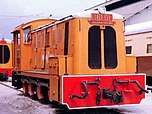 |
North British Locomotive | 1955 | 6 | 16101-16106 | Diesel-Hydraulic | Decommissioned |
| 17 | 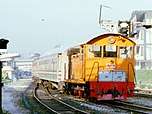 |
Kisha Seizo | 1964 | 15 | 17101-17105 | Diesel-Hydraulic | Decommissioned |
| 18 | 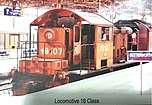 |
Brush HMA | 1978 | 10 | 18101-18110 | Diesel-Electric | Decommissioned |
| 19 | 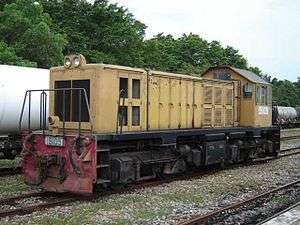 |
Hitachi | 1983 | 10 | 19101-19110 | Diesel-Electric | In Service |
| Class | Image | Manufacturer | Year Built | Built | Numbers | Type | Status |
|---|---|---|---|---|---|---|---|
| 20 | 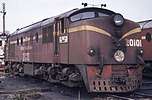 |
Vulcan Foundry | 1957 | 26 | 20101-20126 | Diesel-Electric | Decommissioned |
| 21 | 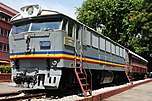 |
Kisha Seizo | 1965
1968 |
25 | 21101-21115
21201-21210 |
Diesel-Hydraulic | Decommissioned |
| 22 | 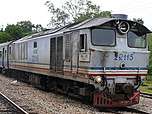 |
English Electric | 1971 | 40 | 22101-22140 | Diesel-Electric | Decommissioned |
| 23 |  |
Hitachi | 1983 | 15 | 23101-23115 | Diesel-Electric | In Service |
| 24 | 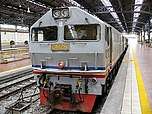 |
Toshiba | 1987 | 26 | 24101-24126 | Diesel-Electric | In Service |
| 25 | 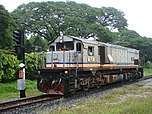 |
Electro-Motive Diesel | 1990
2002 |
17 | 25101-25112
25201-25205 |
Diesel-Electric | In Service |
| 26 | 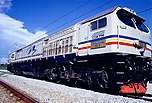 |
Adtranz | 2003 | 20 | 26101-26120 | Diesel Electric | In Service |
| 29 | 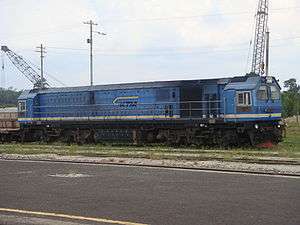 |
Dalian Locomotive
& Rolling Stock |
2005 | 20 | 29101-29120 | Diesel Electric | In Service |
| YDM4 |  |
Diesel Locomotive | 1996 | 33 | 6333-6897 | Diesel Electric | Exported |
| Class | Image | Manufacturer | Year built | Type | Status |
|---|---|---|---|---|---|
| 27 | 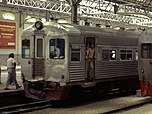 |
Commonwealth Engineering | 1960 | Diesel-Electric Railcar | Decommissioned |
| 28 | 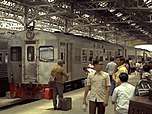 |
Hitachi | 1966 | Diesel-Electric Railcar | Decommissioned |
| Railbus | 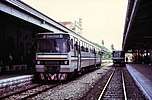 |
Ganz Mavag | 1988 | Diesel Railbus | Decommissioned |
| 61 | 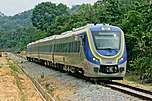 |
CRRC Zhuzhou Locomotive | 2019 | Diesel-Electric
Multiple Unit |
Testing |
| Class | Image | Manufacturer | Year built | Built | Numbers | Status |
|---|---|---|---|---|---|---|
| 81 | 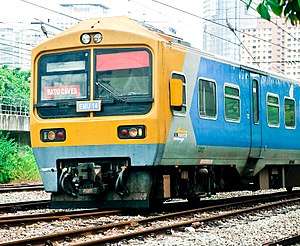 |
Jenbacher | 1994 | 18 | EMU 01-EMU 18 | In service |
| 82 | 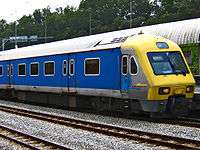 |
Union Carriage & Wagon | 1996 | 22 | EMU 41-EMU 62 | Decommissioned |
| 83 | 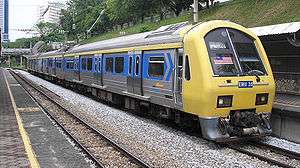 |
Hyundai Rotem | 1996 | 22 | EMU 19-EMU 40 | In Service |
| 92 | CRRC Zhuzhou Locomotive | 2012 | 38 | SCS 01-SCS 38 | In Service |
| Class | Image | Manufacturer | Year Built | Built | Numbers | Status |
|---|---|---|---|---|---|---|
| 91 | Hyundai Rotem | 2009 | 5 | ETS 01-ETS 05 | In service | |
| 93 | .jpg) |
CRRC Zhuzhou Locomotive | 2015
2019 |
19 | ETS 201- ETS 219 | In service |
Northern Depot
- Padang Besar Depot
- ETS Padang Besar Depot
- Bukit Tengah Depot
- Batu Gajah Depot
- ETS Batu Gajah Depot
- Central Workshop Batu Gajah
Central Depot
- KL Sentral Depot
- Port Klang Depot
- Sentul Depot
Southern Depot
- SCS Seremban Depot
- Gemas Depot
- Kempas Baru Depot
East Coast Depot
- Tumpat Depot
- Kuala Lipis Depot
Services
As a national railway company, KTMB is involved in the business of providing rail based transportation. This can be divided into three major services:
a) KTM Intercity
KTM Intercity (Malay: KTM Antarabandar) is the brand name for long-haul passenger train that connect cities and major town served by KTMB rail network.
The service is provided using conventional locomotives hauled coaches. Service span the length of the network, except branch-lines. Daily service convey passengers from Johor Bahru, Johor, to Tumpat, Kelantan and Woodlands, Singapore.
KTM Intercity has also introduce innovative services aimed at making its train not merely a means of transportation. It is possible for customers to rent specialized coaches for event management, conference and even wedding.
It has also been involved in various type of collaborations, joint-promotions, and cross-promotions with all state-level tourism bodies, travel agencies and travel-related industry players in developing rail package for group travellers.
b) KTM ETS
KTM ETS, which stands for Electric Train Service, is a rapid intercity train service by KTM utilising electric train-sets. The service started in 2010 using metre-gauge.
It currently operates between the cities from Gemas, Negeri Sembilan to Padang Besar, Perlis.
The. trains travel up to 140 km/h on electrified lines. the ETS offers its passengers a comfortable and safe travel to their destination at very competitive travel time compared to other modes of transport.
For example, the travel time between KL Sental and Ipoh is about 2 hours and 20 minutes, which compared favorably with the previous intercity train travel time of 3 hours and 30 minutes while buses can take up to 3 hours.
Each train sets is capable of carrying up to 350 passengers. The passengers are waited upon by a team of dedicated on-board steward and stewardess.
c) KTM Komuter
KTM Komuter is a commuter rail service serving the Klang Valley and Northern part of Malaysia.
The central sector consists of the Seremban Line and Port Klang Line. In addition to the main lines, there are shuttle services from Sentul to Batu Caves and Rawang to Tanjong Malim. Since 2018, KTM Komuter also operates an airport train service - the Skypark Link linking KL Sentral to the Subang Airport. The fleet presently consists of Class 81, Class 83 and Class 92 EMUs.
The Northern Sector consists of two routes, namely the Bukit Mertajam-Padang Rengas route as well as the Butterworth-Padang Besar route.
KTM Komuter is a heavily utilised mode of transportation by commuters working in Kuala Lumpur as the service is an alternative for road travel, which is occasionally hampered by congestion. Virtually all KTM Komuter stops offer "Park & Ride" parking lots for those who drive to and from the station or halt. KTM Komuter ridership is estimated to be about 50 million passengers in 2010.
KTM Komuter is currently the most profitable passenger service offered by KTMB, contributing MYR 100 million to group revenue in 2010, higher than KTM Intercity's profit of MYR 70.94 million in the same year.
d) KTM KARGO
KTM Kargo provides cargo conveyance services that are safe and reliable, with a network that spans almost the whole of the KTMB rail network including the branches.
It is therefore highly accessible from seaports and Inland Container Terminal (ICT) as well as industrial centers. with an extensive coverage of areas as well as competitive tariffs, it is a cost-effective way to move goods.
Cargo services is a major contributor to KTM's overall revenue. It is set to further enhnace its role with the rapidly growing demand for transportation of goods.
Currently, there are 45 cargo train services daily with 23 routes daily, of which about 70% are concentrated in the Northern sector. KTMB runs 37 freight train services daily of which about 80% were concentrated in the Northern sector.
Main commodities carried by rail comprise the following:
- Maritime containers
- Landbridge cargos
- Cement
- Sugar
- Gypsum
- Chemicals
Most major ports in Peninsular Network are served by the KTM Kargo network, e.g. Penang Port, Port Klang, Port of Tanjung Pelepas and Pasir Gudang Port.
There is a variety of wagons from a fleet of almost 3,000 to choose from, to cater to almost all types of cargo imaginable to be moved. Is it managed, by a group of customer-focused professionals who are in position to help with the customer's needs and requirements.
Generally, cargo is moved either in open or covered wagons. In the future, all covered wagons will be replaced with containers to allow for flexibility i.e. goods can be dismounted from the train and delivered directly to customers premises thus, living up to the concept of door-to-door delivery.
Non-rail Subsidiaries
KTM operates several non-rail subsidiaries. Though considered as non-core businesses, KTMB has benefited from these operations, especially from Property and Advertising segments.
- Property
The property joint ventures were progressing comparatively well under the prevailing economic climate. As part of the Sentul Raya Development, the Maple Condominium was handed over to purchasers in August 2006 while the Saffron Condominium is under construction and expected to be completed in 2007. Meanwhile, KL Sentral Development has embarked on construction of luxury condominiums, new office towers and life-style centre whilst the construction of the Marine View Hotel in Port Dickson is expected to be completed in 2007. To cater for demand from surrounding residential areas, KTMB's partner for the Prai Perdana Development is in the process of constructing a new retail complex and the project is expected to be completed in 2007.
- Advertising
Through KTMB's collaboration with Ganad Media Sdn. Bhd. the advertising revenue had increased by 9.7% to RM1.47 million compared to the previous year. Several new advertising structures have been built in Klang Valley while more on-train advertising media like panels and hand-grips were made available on top of the increased demand for 'wrap-around' advertising on the commuter trains.
- Multimodal Freight (MMF)
Multimodal Freight Sdn. Bhd., incorporated in 1988, was licensed as a Government approved Container Haulier in 1991, and went on to obtain the Government approved Multimodal Transport Operator (MTO) status in 1999. The company operates a fleet of 225 Prime Movers and 1,300 trailer of both 20-feet and 40-feet configurations. The fleet is deployed at all major seaports and the inland ports of Ipoh and Nilai.[2]
- KTM Distribution (KTMD)
Its core business is in the provision of express parcel distribution services to the commercial, industrial and administrative sectors and it operates within Malaysia and Singapore. Parcel distribution is carried out through its door-to-door service or from point to point through its station-to-station service. The company is also licensed by the Malaysian Communications & Multimedia Commission as a courier service provider, which enables it to carry letters and documents up to 2 kg. This service has so far been monopoly of the Postal Department. The company owns an 18,000 sq ft (1,700 m2). freehold property in Sri Damansara, from which it earns warehouse rental income.[3]
Modernisation
Since the corporatisation of KTMB, a programme of modernization has been underway. In 1989, it embarked on the double-tracking and electrification of the trunk line between Rawang and Seremban, the branch lines between Batu Junction and Sentul and between Kuala Lumpur and Port Klang, allowing KTM Komuter services to start running in 1995.[4] The next major project was the Rawang-Ipoh double tracking and electrification project, which started in 2000, but delays held back its completion to 2008. This enabled ETS services to start in 2010, bringing electric traction to intercity travel in Malaysia for the first time. In 2002, the Malaysian government proposed the ambitious project of electrifying and double-tracking the entire western line and awarded contracts in 2003. The project was however put on hold by Prime Minister Abdullah Badawi until March 2007 when Deputy Prime Minister Najib Razak announced the project's revival. In April 2007, the government announced that contracts for certain portions of the project had been awarded. Since then, work has progressed rapidly, and presently the West Coast Line is electrified from Padang Besar to Gemas, with the remaining section to Johor Bahru set to be electrified in 2022.
Completed Projects
- Rehabilitation of 327 km-long meter gauge tracks from Paloh to Singapore and from Slim River to the main Seremban line in Malaysia (1988–1994) (US$70 million)
- Electrification and double tracking of the Rawang-Seremban route (1990–1994) (US$62 million)
- Electrification and double tracking of the Kuala Lumpur-Port Klang railway route, including spur lines to Subang Jaya and Sentul (1991–1994) (US$66 million)
- Construction of railway bridges, road over bridges and underpasses along the Rawang-Kajang route (1991–1994) (US$6 million)
- Construction of railway bridges, road over bridges and underpasses along the Kajang-Seremban route (1991–1994) (US$16 million)
- Widening of railway tunnels near Seremban (1994–1995) (US$4 million)
- Construction of railway culverts and box pushing along the Nilai-Seremban route (1994–1995) (US$4 million)
- Track linking Port Klang to Pulau Indah (1997–1999) (US$4 million)
- Construction of the Port of Tanjung Pelepas, a rail link in Johor (1999–2002) (US$121 million)
- Track works at Kuala Lumpur Sentral station (1999–2001) (RM14.3 million)
- Electrification and double tracking of the Rawang-Ipoh route (2000-2008) (RM2.57 billion)
- Electrification and double tracking of the Sentul-Batu Caves route (2006-2010) (RM515 million)
- Electrification and double tracking of the Seremban-Gemas route (2008-2013) (RM3.45 billion)
- Electrification and double tracking of the Ipoh-Padang Besar route (2008-2014) (RM12.5 billion)
- Electrification and double tracking of Subang Jaya-Subang Airport route (2013-2018) (RM521 million)
Current Projects
- Electrification and double tracking of Gemas-JB route (2018-2022)
- Rehabilitation of tracks in the Klang Valley(KVDT), Phase 1 (2016-2024)[5]
- Rehabilitation of tracks in the Klang Valley (KVDT), Phase 2 (2019 - 2027)
- Rehabilitation of tracks Gemas - Mentakab (Package A) (2016 - 2020)
- Rehabilitation of tracks Jerantut - Gua Musang (Package B) (2016 - 2020)
- Rehabilitation of tracks Gua Musang - Tumpat (Package C) (2016 -2020)
Proposed projects
- Outer Ring Railway Service to connect all suburbs in the Klang Valley without going through the city center.[6]
- Construction of the Subang Jaya - Sungai Buloh Link which will act as a freight bypass to avoid freight trains from having to enter the Kuala Lumpur Komuter network. Works are divided into two phases; Phase 1 is from Subang Jaya - Subang Airport, Phase 2 is from Subang Airport - Sungai Buloh. As of now, Phase 1 had already been completed.
- A new integrated station named Penang Sentral will be built which will connect KTM Railway, monorail, bus and ferry service in one building at Butterworth.
- Extension of the ETS service to Hat Yai by 2021
Board of directors
- Chairman: Y.B Datuk Dr. Rameli Musa .
- Chief Executive Officer (CEO): YBhg. Datuk Ir. Kamarulzaman bin Zainal.
- Non-Independent, Non-Executive Directors: Y. Brs Encik Mohd Hassan Ahmad , Y.Bhg Dato'Jana Santhiran a/l Muniayan , Y. Brs Encik Azhar Noraini
- Independent Non-Executive Directors: Y. Brs Encik Md Silmi Abd Rahman, Y. Brs Encik Nazri Ismail, YBhg. Dato’ Prof. Dr. Sudin bin Haron
- Heads of Strategic Business Units;
- KTM Intercity: Encik Afzar Zakariya
- KTM Komuter: Encik Roshidi Yahaya
- KTM Kargo: Encik Mohd Din Mohamad
Previous and current logos
 Malayan Railways 1948-1984
Malayan Railways 1948-1984 KTM 1985-1991
KTM 1985-1991 KTM 1992–present
KTM 1992–present
See also
References
- "KTM Berhad - Transport Malaysia"
- "Multimodal Freight Sdn. Bhd. Company Info". KTM berhad.
- "KTM Distribution Company Info". KTM Berhad. Archived from the original on 16 January 2009.
- "KTM projects introduction". Archived from the original on 26 August 2007. Retrieved 14 June 2007.
- "Rehabilitation of double track could be ready in 5 years: Loke". Malaysiakini. 3 September 2019. Retrieved 11 September 2019.
- "Commuter line for suburbs". The Star. Archived from the original on 21 April 2008. Retrieved 17 April 2008.
